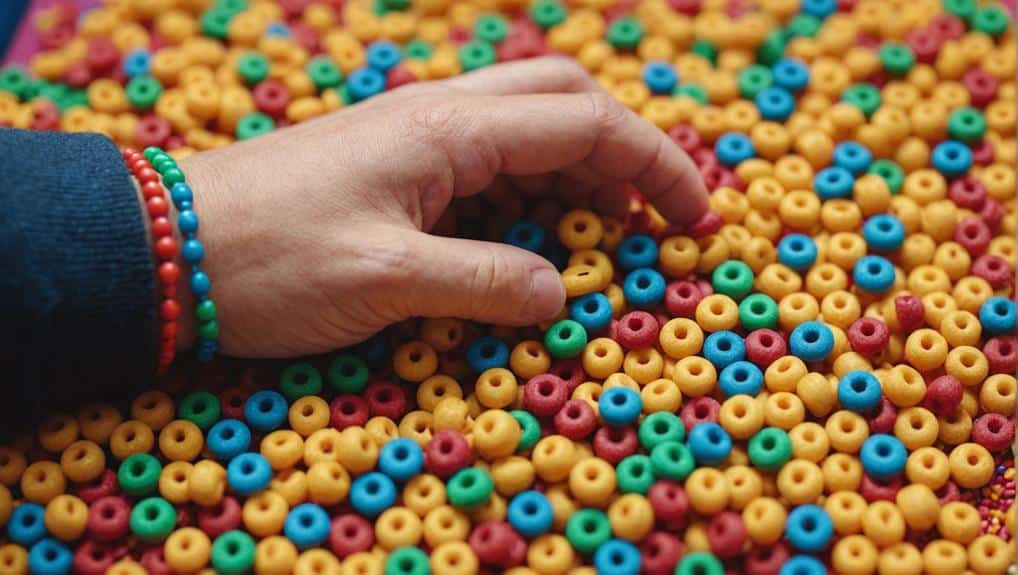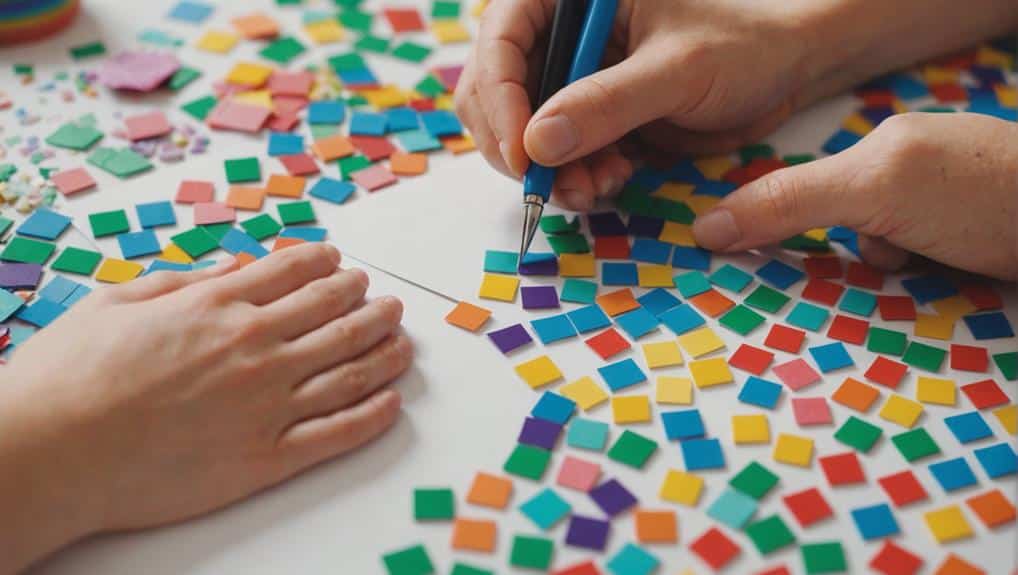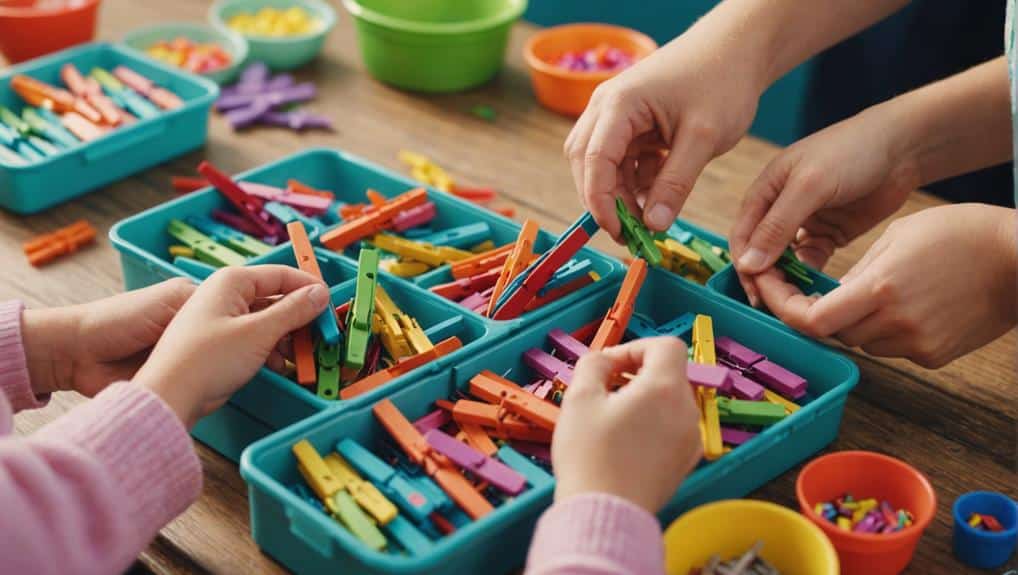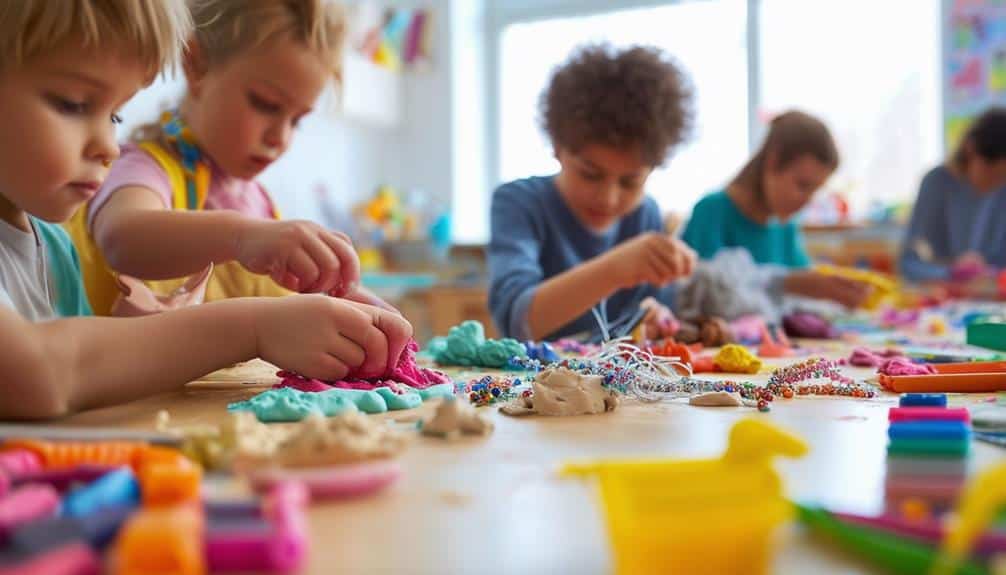Improving fine motor skills in children is crucial for their development. Simple activities like sticker exercises enhance pincer grip and visual motor coordination. These tasks are easy to do and can be lots of fun for kids.
Stringing Cheerios helps develop hand-eye coordination and finger dexterity. Paper mosaic crafts strengthen hand muscles while fostering creativity and precision. Each of these activities provides a unique way to build fine motor skills.
Coin-sorting games refine the pincer grasp, boost concentration, and improve problem-solving skills. Clothespin challenges enhance hand strength and coordination, essential for dressing independently. These Fine Motor Tips can support your child’s progress and ensure they develop vital skills.
Key Takeaways
- Practice sticker activities to enhance pincer grip, hand-eye coordination, and fine motor skills.
- Engage in stringing Cheerios for improved finger dexterity and bilateral coordination.
- Create paper mosaic crafts to strengthen hand muscles and develop pincer grasp.
- Play coin-sorting games to refine precision handling and boost cognitive skills.
- Participate in clothespin challenges to build hand strength and promote independent dressing skills.
Sticker Activities
Engaging children in sticker activities is an effective method to enhance their pincer grip and visual-motor coordination. Caregivers can provide necessary acceptable motor skill practice by having children place and peel stickers from their hands or clothing. This activity strengthens hand muscles and promotes precision grasping, which is essential for everyday tasks.
Caregivers can draw open circles on paper to further develop hand-eye coordination and encourage children to place stickers within these boundaries. This exercise promotes accuracy and control, helping children to refine their visual motor coordination. Moreover, peeling and placing stickers demands a pincer grip, essential for tasks such as buttoning clothes and writing.
Sticker activities are beneficial and enjoyable for children. The element of creativity involved in selecting and placing stickers makes the exercise fun and engaging. As children explore different sticker designs and patterns, they enhance their fine motor skills.
This dual benefit of fun and functional development makes sticker activities an excellent tool for caregivers and educators aiming to serve others by fostering necessary developmental skills in children.
Stringing Cheerios

Stringing Cheerios, a simple yet highly effective exercise, offers an excellent chance to enhance children’s fine motor skills through hands-on practice. This engaging activity integrates multiple delicate motor tasks, allowing children to refine their hand-eye coordination, pincer grip, and concentration.
Utilizing everyday items like pipe cleaners, spaghetti, or string for threading Cheerios can significantly strengthen these essential abilities.
Stringing Cheerios encourages bilateral coordination, as children must use both hands in harmonious cooperation. This bilateral coordination is vital for daily tasks such as dressing and writing. Moreover, threading small objects like Cheerios requires precise finger dexterity, further enhancing fine motor skills.
What makes this exercise particularly attractive is its versatility and cost-effectiveness. Stringing Cheerios is an inexpensive yet powerful tool, ideal for home and classroom settings. It offers a fun, interactive way to support children’s developmental needs without demanding extensive resources.
Paper Mosaic Crafts

Paper mosaic crafts provide an excellent opportunity for children to enhance their fine motor skills by manipulating paper creatively. This activity involves tearing paper into small pieces and arranging these fragments to form distinct artwork. Tearing paper helps strengthen hand muscles, promoting the development of a bimanual tripod grasp, essential for tasks such as writing and cutting with scissors.
Engaging in paper mosaic crafts also fosters pincer grasp development, a critical skill for handling small objects. As children place each piece of paper, they improve their visual-motor coordination, which integrates visual input with acceptable motor actions. This coordination is fundamental for activities that require precision and accuracy, such as buttoning a shirt or tying shoelaces.
Moreover, the process of creating textured designs with paper not only enhances fine motor skills but also encourages creativity and self-expression. This can be particularly beneficial for children as they develop their artistic abilities and gain confidence in their skills.
Coin Sorting Games

Coin-sorting games are practical and engaging methods for enhancing fine motor skills in children. They promote hand-eye coordination and precision in handling small objects. These activities allow children to refine their pincer grasp and finger strength by sorting coins based on size, color, or denomination. Such tasks boost physical talent and encourage the development of concentration, problem-solving, and cognitive skills.
Playing coin-sorting games can enhance children’s hand dexterity and finger control. These games offer a versatile and adaptable approach that can be tailored to various skill levels, making them suitable for different age groups and abilities.
To create a vivid image of coin-sorting games, consider the following elements:
- Sorting coins by size: Encourages children to distinguish between large and small coins.
- Color coding coins: Enhances visual discrimination and organizational skills.
- Stacking coins: Develops steadiness and precision in hand movements.
- Using tweezers: Strengthens the pincer grasp and finger muscles.
- Timed challenges: Boosts concentration and problem-solving under pressure.
Incorporating coin-sorting games into daily routines provides an enjoyable and educational way to foster children’s fine motor skills, ultimately contributing to their overall cognitive and physical development.
Clothespin Challenges

Incorporating clothespin challenges into children’s activities offers a practical and enjoyable way to strengthen fine motor skills and enhance hand-eye coordination. These engaging tasks, such as attaching clothespins to board books or clothing items, play a significant role in developing hand strength and precision grasp. By integrating these activities into daily routines, children can gradually improve their fine motor control, essential for various aspects of daily living.
Clothespin challenges bolster hand and finger strength and contribute to improved body awareness. This is especially advantageous as it supports independent dressing skills in children, fostering a sense of autonomy and self-confidence. Occupational therapy often utilizes such activities to target specific fine motor skills, making them valuable tools for therapists and caregivers.
To maximize the benefits, consider varying the objects to which clothespins are attached, introducing different textures and resistances. This enhances the child’s tactile experiences and further challenges their motor skills. By methodically incorporating clothespin activities, caregivers can provide an enriching, therapeutic environment that aids in the holistic development of a child’s fine motor abilities.
Frequently Asked Questions
What Activities Develop Fine Motor Skills?
Activities that develop fine motor skills include coloring, cutting, buttoning garments, manipulating playdough, bead stringing, and engaging in arts and crafts. These tasks enhance hand-eye coordination, finger strength, and agility, which are essential for writing and drawing.
How Can I Practice Fine Motor Skills at Home?
To practice fine motor skills at home, engage in activities such as cutting paper, threading beads, and using tongs. These exercises improve hand strength and coordination, essential for precision and dexterity tasks.
What Are 5 Fine Motor Tips?
Five excellent motor skills for daily functioning include writing, cutting with scissors, buttoning clothing, picking up small objects, and using utensils. These skills are fundamental for independence and effective tool use in various tasks.
What Is an Activity That Requires Fine Motor Skills?
Threading beads onto string is an activity requiring fine motor skills. This task enhances finger dexterity, hand-eye coordination, and grip strength, making it essential for developing the fine motor control needed for everyday tasks.
Conclusion
Fine motor skill exercises are like a gardener tending to delicate plants; consistent, careful practice yields flourishing results. Incorporating sticker tasks, stringing Cheerios, and paper mosaic crafts helps improve children’s fine motor skills and build hand-eye coordination.
An American Occupational Therapy Association study showed that regular engagement in these motor activities significantly improves children’s skills. Simple activities such as coin sorting games and clothespin challenges can make a big difference. These activities enhance pincer grip and foster concentration and problem-solving abilities.
Incorporating these motor tasks into daily routines helps children achieve greater independence in everyday activities. Use tools like beads, Jumbo Tweezers, and paper cups to create fun and engaging motor skill activities. Giving children lots of practice with these simple activities supports overall motor development and builds solid foundations for future handwriting and other essential skills.


Recent Comments